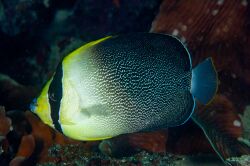Biology:Chaetodontoplus poliourus
From HandWiki
Short description: Species of marine fish
| Chaetodontoplus poliourus | |
|---|---|

| |
| Scientific classification | |
| Domain: | Eukaryota |
| Kingdom: | Animalia |
| Phylum: | Chordata |
| Class: | Actinopterygii |
| Order: | Perciformes |
| Family: | Pomacanthidae |
| Genus: | Chaetodontoplus |
| Species: | C. poliourus
|
| Binomial name | |
| Chaetodontoplus poliourus Randall & Rocha, 2009
| |
Chaetodontoplus poliourus, the greytail angelfish, is a species of marine fish belonging to the family Pomacanthidae. It is similar to its sister species Chaetodontoplus mesoleucus, and the two were considered as being the same species for a long time. However, they can be readily distinguished by the color of their tails: C. poliurus has a grey tail, whereas C. mesoleucus has a yellow tail.[1] The Greytail Angelfish can be found in inshore reefs and lagoons of the western Pacific, from Indonesia to Palau and Solomon Islands.[2] It's rare in the aquarium trade, but highly sought after,[3] and listed as Least Concern by the IUCN Red List.[4]
References
- ↑ Randall & Rocha (2009). "Chaetodontoplus poliourus, a new angelfish (Perciformes: Pomacanthidae) from the Tropical Western Pacific". The Raffles Bulletin of Zoology 57: 511–520. https://lkcnhm.nus.edu.sg/wp-content/uploads/sites/10/app/uploads/2017/06/57rbz511-520.pdf.
- ↑ "Chaetodontoplus poliourus, Greytail angelfish". https://www.fishbase.de/summary/Chaetodontoplus-poliourus.html.
- ↑ Adams, Jake (2017-09-18). "The Best Pictures Yet Of The Rare Greytail Angelfish" (in en-US). https://reefbuilders.com/2017/09/18/the-best-pictures-yet-of-the-rare-greytail-angelfish/.
- ↑ Richard Pyle (Bishop Museum, Hawaii; Texas), Luiz Rocha (University of; Rico), Matthew Craig (University of Puerto (2009-10-08). IUCN Red List of Threatened Species: Chaetodontoplus poliourus. doi:10.2305/iucn.uk.2010-4.rlts.t168374a6484924.en. https://www.iucnredlist.org/en. Retrieved 2021-02-26.
Wikidata ☰ Q6428509 entry
 |



